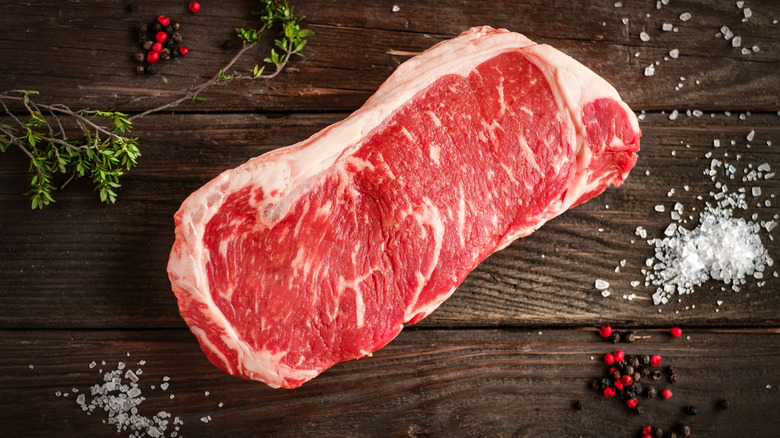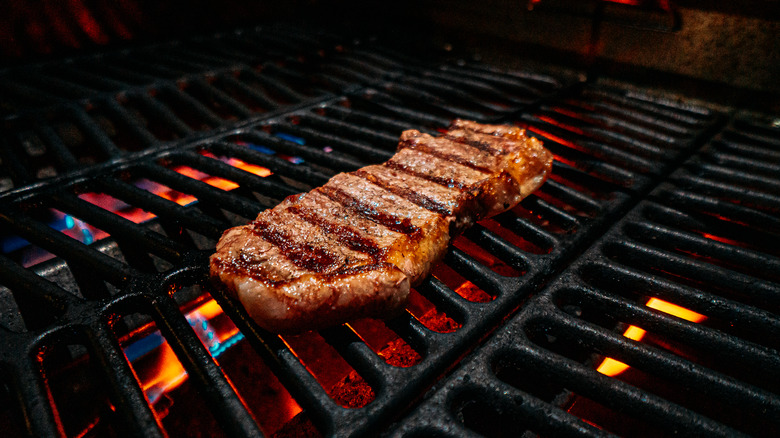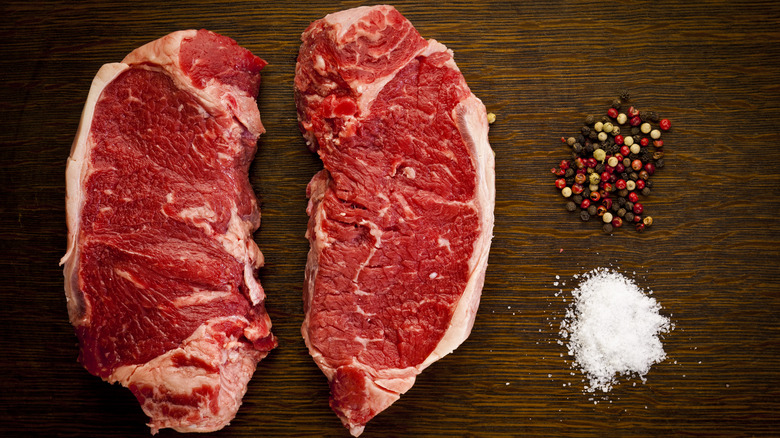What's The Best Way To Cook A New York Strip Steak?
The New York Strip steak is one of the most well-known cuts of beef and a staple of steakhouse menus across the country. It goes by other names, including strip loin, top loin, shell steak, ambassador steak, and Omaha Strip, but it will always be most associated with the Big Apple. Legendary Manhattan steakhouse Delmonico's has popularized the New York Strip and cemented its high-echelon status. It's not a cheap cut by any means, averaging around $19.99 per pound. So if you're going to invest in this cut, you owe it to yourself to prepare it to the highest standards. The wrong cooking method could make this steak a tough, chewy mess.
The New York Strip needs to be cooked quickly to keep it tender. It comes from the longissimus dorsi muscle along the cow's back. It's a muscle that does very little work in terms of movement, which helps it stay tender, as opposed to cuts taken from the cow's shoulder and leg regions, such as chuck. (This muscle is also the source of ribeye steaks. But compared to them, strip steaks have less intramuscular fat, making them somewhat tougher and more sensitive to slow cooking methods.)
The strip steak is also in the same region as the popular filet mignon. In fact, T-bone and porterhouse steaks are made up of the strip and filet, separated by a bone. When cooking strip steaks, take a cue from the filet mignon and use high heat.
Strip steaks should be cooked high and fast
Barbecue experts often talk about cooking meats "low and slow." But you want to do the exact opposite when it comes to the New York Strip. Having a relatively low level of marbling, the strip will get tough and dry if you cook it for too long. Instead, cook strip steaks on a grill or pan cranked up to the highest heat. You want to get a good sear on all sides and do so quickly before the steak's interior turns tough and gray. Another excellent option for New York Strip steaks is to place them under a broiler, which essentially accomplishes the same thing as a grill, except that the heat comes from above rather than below the steak.
The ideal cooking time will depend on your preferred level of doneness, ranging from 3-4 minutes per side for a rare steak up to 5-6 minutes per side for a well-done steak. If you want total control over the temperature of the steak, another cooking option is the sous vide method, although this requires special equipment.
Strip steaks are usually sold boneless, but you can get them with the bone attached (this is sometimes called a Kansas City Strip), which helps lock in moisture. And one last thing: the biggest perk of a New York Strip steak is its robust flavor. Keep the seasonings simple, with just some salt and pepper.
What makes the New York Strip steak so unique
A significant key to the New York Strip's appeal is that it has an intensely beefy flavor without a great deal of fat. Typically, fattier cuts of meat are more flavorful, which is why the strip steak and filet mignon are considered such standouts. The key is in the muscle makeup. We already mentioned that strip steaks come from the longissimus dorsi muscle, but more specifically, it comes from a larger cut called the beef short loin. The short loin is derived from an even larger cut called the loin. It's one of the primal cuts, a term referring to the largest segments of meat that represent the first stage of butchering a cow. The loin comprises the muscles that run from the end of the cow's ribs back to its hips. The loin primal is divided into two subprimals, with the short loin closest to the ribs and the sirloin closest to the hips.
The short loin is a reasonably small cut, about 16-18 inches in length, and it yields 11-14 individual steaks. The short loin plays almost no role in the cow's movement, meaning it hardly gets exercised. This is why it can remain relatively tender despite being quite lean. Most of the hard, gristly fat that makes certain cuts unpleasant to eat is intermuscular fat, meaning the fat that forms between muscles. Since strip steaks are cut entirely from one muscle, they avoid that pitfall.


